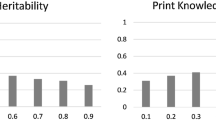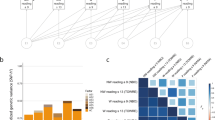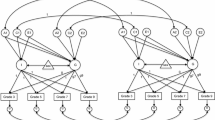Abstract
Grade 1 literacy skills of twin children in Australia (New South Wales) and the United States (Colorado) were explored in a genetically sensitive design (N = 319 pairs). Analyses indicated strong genetic influence on word and nonword identification, reading comprehension, and spelling. Rapid naming showed more modest, though reliable, genetic influence. Phonological awareness was subject to high nonshared environment and no reliable genetic effects, and individual measures of memory and learning were also less affected by genes than nonshared environment. Multivariate analyses showed that the same genes affected word identification, reading comprehension, and spelling. Country comparisons indicated that the patterns of genetic influence on reading and spelling in Grade 1 were similar, though for the U.S. but not the Australian children new genes came on stream in the move from kindergarten to Grade 1. We suggest that this is because the more intensive kindergarten literacy curriculum in New South Wales compared with Colorado, consistent with the mean differences between the two countries, means that more of the genes are “online” sooner in Australia because of accelerated overall reading development.
Similar content being viewed by others
References
Adams W., Sheslow D. (1990). Wide range assessment of memory and learning Wilmington, Delaware Jastak Associates
Bates, T. C., Castles, A., Luciano, M., Wright, M., Coltheart, M., & Martin, N. G. Genetic and environmental bases of reading and spelling: A unified genetic dual route model. Reading and Writing: An Interdisciplinary Journal (in press)
Bishop D. V. M., (1989). Test for reception of grammar (TROG) 2 Abingdon, UK Medical Research Council
Byrne B., Delaland C., Fielding-Barnsley R., Quain P., Samuelsson S., Hoien T., Corley R., DeFries J. C., Wadsworth S., Willcutt E. G., Olson R. K. (2002). Longitudinal twin study of early reading development in three countries: Preliminary results Annals of Dyslexia 52:49–73
Byrne B., Wadsworth S., Corley R., Samuelsson S., Quain P., DeFries J. C., Willcutt E. G., Olson R. K. (2005). Longitudinal twin study of early literacy development: Preschool and kindergarten phases Scientific Studies of Reading 9:219–235
Byrne B., Olson R. K., Samuelsson S., Wadsworth S., Corley R., DeFries J. C., Willcutt E. G. (2006). Genetic and environmental influences on early literacy Journal of Research in Reading 29:33–49
Cope N., Harold D., Hill G., Moskvina V., Stevenson J., Holmans P., Owen M. J., Oȁ9Donovan M. C., Williams J. (2005) Strong evidence that KIAA0319 on chromosome 6p is a susceptibility gene for developmental dyslexia American Journal of Human Genetics 76:581–591
Coventry W. L., Keller M. C. (2005). Exploring the extent of parameter bias in the Classical Twin Design: A comparison of parameter estimates from the Extended Twin-Family and Classical Twin Designs Twin Research and Human Genetics 8:214–223
Curtis M. E. (1980). Development of components of reading skill Journal of Educational Psychology 72:656–669
Deffenbacher K. E., Kenyon J. B., Hoover D. M., Olson R. K., Pennington B. F., DeFries J. C., Smith S. D. (2004). Refinement of the 6P21.3 QTL influencing dyslexia: Linkage and association analyses Human Genetics 115:128–138
Elbro C., Petersen D. K. (2004). Long-term effects of phoneme awareness and letter sound training: An intervention study with children at risk for dyslexia Journal of Educational Psychology 96:660–670
Fisher S. E., DeFries J. C. (2002). Developmental dyslexia: genetic dissection of a complex cognitive trait Nature Reviews Neuroscience 3:767–780
Foulin J. N. (2005). Why is letter-name knowledge such a good predictor of learning to read? Reading & Writing: An Interdisciplinary Journal 18:129–155
Gayán J., Olson R. K. (2001). Genetic and environmental influences on orthographic and phonological skills in children with reading disabilities Developmental Neuropsychology 20(2):487–511
Gayán J., Olson R. K. (2003). Genetic and environmental influences on individual differences in printed word recognition Journal of Experimental Child Psychology 84:97–123
Hannula-Jouppi K., Kaminen-Ahola N., Taipale M., Eklund R., Nopola-Hemmi J., Kääriäinen H., & Kere J. (2005). The axon guidance receptor gene ROBO1 is a candidate gene for developmental dyslexia. Public Library of Science: Genetics, 1(4) e50, 0467–0474
Harlaar N., Spinath F. M., Dale P. S., Plomin R. (2005). Genetic influences on early word recognition abilities and disabilities: A study of 7-year-old twins Journal of Child Psychology and Psychiatry 46:373–384
Hindson B. A., Byrne B., Fielding-Barnsley R., Newman C., Hine D. W., Shankweiler D. (2005). Assessment and early instruction of preschool children at risk for reading disability Journal of Educational Psychology 97:687–704
Hoover W. A., Gough P. B. (1990). The simple view of reading Reading & Writing: An Interdisciplinary Journal 2:127–160
Jastak S., Wilkinson G. S. (1984). The wide range achievement test-revised:administration manual Wilmington, DE Jastak Associates, Inc
Juel C. (1988). Learning to read and write: A longitudinal study of 54 children from first through fourth grades Journal of Educational Psychology 80:437–447
Keenan J. M., Betjemann R., Wadsworth S. J., DeFries J. C., Olson R. K. (2006). Genetic and environmental influences on reading and listening comprehension Journal of Research in Reading 29:75–91
Keller M. C., Coventry W. L. (2005). Quantifying and addressing parameter indeterminacy in the Classical Twin Design Twin Research and Human Genetics 8:201–213
McGue M., Bouchard T. J. Jr., Iacono W. G., Lykken D. T. (1993). Behavioral genetics of cognitive ability: A lifespan perspective In: R. Plomin, G. E. McClearn (Eds) Nature, nurture, and psychology Washington, DC American Psychological Association (pp. 59–76)
Mehta P. D., Foorman B. R., Branum-Martin L., Taylor W. P. (2005). Literacy as a unidimensional multivlevel construct: Validation,sources of influence, and implications in a longitudinal study in Grades 1 to 4 Scientific Studies of Reading 9:85–116
Meng H., Smith S. D., Hager K., Held M., Liu J., Olson R. K., Pennington B. F., DeFries J. C., Gelernter J., Oȁ9Reilly-Pol T., Somlo S., Skudlarski P., Shaywitz S. F., Shaywitz B. A., Marchione K., Wang Y., Paramasivam M., LoTurco J. J., Page G. P., Gruen J. R. (2005). DCDC2 is associated with reading disability and modulates neuronal development in the brain Proceedings of the National Academy of Sciences 102:17053–17058
Morrison F. J., Griffith E. M., Alberts D. M. (1997). Nature–nurture in the classroom: Entrance age, school readiness, and learning in children Developmental Psychology 33:254–262
Neale M. C., Boker S. M., Xie G., & Maes H. H. (2002). Mx: Statistical Modeling. VCU Box 900126, Richmond, VA 23298: Department of Psychiatry. 6th Edition
Olson R. K., Byrne B. (2005). Genetic and environmental influences on reading and language ability and disability In: H. Catts, A. Kamhi (Eds) The connections between language and reading disabilities Mahwah, NJ Laurence Erlbaum Associates (pp. 173–200)
Olson R. K., Forsberg H., Wise B. (1994). Genes, environment, and the development of orthographic skills In: V.W. Berninger (Eds) The varieties of orthographic knowledge I: Theoretical and developmental issues Dordrecht, The Netherlands Kluwer Academic Publishers, (pp. 27–71)
Olson R. K., Wise B., Conners F., Rack J., Fulker D. (1989). Specific deficits in component reading and language skills: Genetic and environmental influences Journal of Learning Disabilities 22:339-348
Pennington B. F., Olson R. K. (2005). Genetics of dyslexia In: M. Snowling, C. Hulme (Eds) The science of reading: A handbook Oxford Blackwell Publishing (pp. 453–472)
Perfetti C. A., Landi N., Oakhill J. (2005). The acquisition of reading comprehension skill In: M. Snowling, C. Hulme (Eds) The science of reading: A handbook Oxford Blackwell (pp. 227–247)
Petrill S. A., Deater-Deckard K., Schatschneider C., Davis C. (2005). Measured environmental influences on early reading: Evidence from an adoption study Scientific Studies of Reading 9:237–260
Petrill, S. A., Deater-Deckard, K., Thompson, L. A., & DeThorne, L. S. (2006). Reading skills in early readers: Genetic and shared environmental influences. Journal of Learning Disabilities, 39, 48–55
Petrill, S. A., Deater-Deckard, K., Thompson, L. A., DeThorne, L. S., & Schatschneider, C. (2006). Genetic and environmental effects of serial naming and phonological awareness on early reading outcomes, Journal of Educational Psychology, 98, 112–121
Petrill, S. A., Deater-Deckard, K., Thompson, L. A., Schatschneider, C., & DeThorne, L. S. (in press). Reading and Writing: An Interdisciplinary Journal
Plomin R., DeFries J. C., McClearn G. E., McGuffin P. (2001). Behavioral genetics 4 New York Worth
Samuelsson S., Byrne B., Quain P., Wadsworth S., Corley R., DeFries J. C., Willcutt E. G., Olson R. K. (2005). Environmental and genetic influences on prereading skills in Australia, Scandinavia, and the United States Journal of Educational Psychology 97:705–722
Samuelsson, S., Olson, R. K., Wadsworth, S., Corley, R., DeFries, J. C., Willcutt, E., Hulslander, J., & Byrne, B. (in press). Genetic and environmental influences on pre-reading skills and early reading and spelling development: A comparison between the United States, Australia, and Scandinavia. Reading and Writing: An Interdisciplinary Journal
Schumacher J., Anthoni H., Dahdouh F., König I. R., Hillmer A. M., Kluck N., Manthey M., Plume E., Warnke A., Remschmidt H., Hülsmann J., Cichon S., Lindgren C. M., Propping P., Zucchelli M., Ziegler A., Peyrard-Janvid M., Schulte-Körne G., Nöthen M. M., Kere J. (2006). Strong genetic evidence of DCDC2 as a susceptibility gene for dyslexia American Journal of Human Genetics 78:52–62
Taipale M., Kaminen N., Nopola-Hemmi J., Haltia T., Myllyluoma B., Lyytinen H., Muller K., Kaaranen M., Lindsberg P. J., Hannula-Jouppi K., Kere J. (2003). A candidate gene for developmental dyslexia encodes a nuclear tertatricopeptide repeat domain protein dynamically regulated in the brain Proceedings of the National Academy of Sciences 20:11553–11558
Thomas C. J. (1905). Congenital word-blindness and its treatment Ophthalmoscope 3:380–385
Torgesen J., Wagner R., Rashotte C. A. (1999). A test of word reading efficiency (TOWRE) Austin, Texas PRO-ED
Wadsworth S. J., Corley R. P., Hewitt J. K., Plomin R., DeFries J. C. (2002). Parent-offspring resemblance for reading performance at 7:12, and 16 years of age in the Colorado Adoption Project Journal of Child Psychology and Psychiatry and Allied Disciplines 43(6):769–774
Wagner R. K., Torgesen J. K., Rashotte C. A. (1999). The comprehensive test of phonological processes (CTOPP) Austin, Texas PRO-ED
Wechsler D. (1989). Manual for the wechsler preschool and primary scale of intelligence-revised New York Psychological Corporation
Woodcock R. W. (1989). Woodcock reading mastery tests Circle Pines, MN American Guidance Service
Acknowledgements
The research was supported by the Australian Research Council (A79906201), the National Institute for Child Health and Human Development (HD27802 and HD38526), the Research Council of Norway (154715/330), the Swedish Research Council (345-2002-3701), and Stavanger University. We are grateful for support from the Australian Twin Registry and the Australian Multiple Birth Association. We also thank our testers: in Australia, Frances Attard, Nicole Church, Marreta Coleman, Cara Newman; in Norway, Bjarte Furnes; in Sweden, Inger Fridolfsson; in the USA, Kim Corley, Rachael Cole, Barb Elliott, Kari Gilmore, Angela Villella, and Ingrid Simece.
Author information
Authors and Affiliations
Corresponding author
Rights and permissions
About this article
Cite this article
Byrne, B., Samuelsson, S., Wadsworth, S. et al. Longitudinal twin study of early literacy development: Preschool through Grade 1. Read Writ 20, 77–102 (2007). https://doi.org/10.1007/s11145-006-9019-9
Accepted:
Published:
Issue Date:
DOI: https://doi.org/10.1007/s11145-006-9019-9




